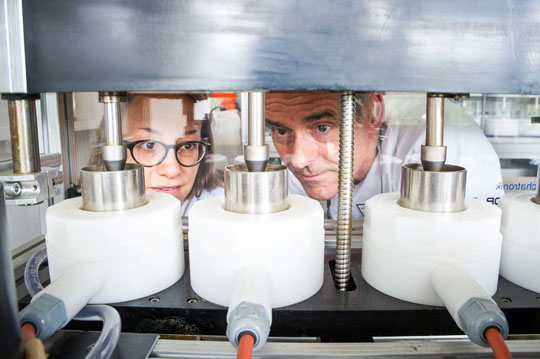Dental replacements should last 60 years
Freiburg, Sep 18, 2017
Teeth, including prosthetics, have to deal with about 250,000 bites per year. That means implants from a new type of ceramic for tooth replacement would have to handle chewing 15 million times as they should last for 60 years. Eight researchers under Prof. Dr. Ralf Kohal, Associate Chair in the Department of Prosthetic Dentistry and Dr. Brigitte Altmann, Director of the scientific laboratory at the Department of Oral and Maxillofacial Surgery (MKG) have tested it. "The new implants are a real improvement," says Kohal, who is also a dentist. Altmann, who is a biologist, is particularly pleased that the cell culture tests during animal testing led to the same results.
 With the help of a chewing machine, Brigitte Altmann and Ralf Kohal were able to test various materials' physical stability for dental prostheses.
With the help of a chewing machine, Brigitte Altmann and Ralf Kohal were able to test various materials' physical stability for dental prostheses.
Photo: Klaus Polkowski
Chewing a great deal barely affects implants, explains Kohal: "A very small percentage of them actually break." It is bacteria that often creates the damage. Through bacterial invasion the tissue surrounding the implant gets infected. As a result, bone loss occurs and the prosthetic falls out too. "Customarily, bone grows around the implant fairly well," says Kohal. Nearly 95 percent of traditional dental prostheses last at last ten years. Only one in 20 patients is confronted with a troublesome replacement within the first decade.
The European LONGLIFE project in which researchers from five countries participated sought to reduce that number while increasing the longevity of dental prostheses. The project's initiators invited three Freiburg dental departments to participate: Department of Prosthetic Dentistry, the Department of Restorative Dentistry and Periodontology as well as the Department of Oral Biotechnology. They were tasked with conducting biological testing of materials that were deemed the most stabile from stress tests done by French, Italian and Swedish material scientists.
Ten varieties analyzed
"We analyzed ten varieties that were made of various materials or had different surface structures," says Altmann. A chewing machine determined how much chewing under the influence of water stressed the implants. At the same time, the researchers populated special test specimens similar to implants in petri dishes with bone cells and soft tissue cells. They grew particularly well in four of the varieties. "We conducted gene expression profiling with them," claims the biologist.
The researchers took a look at how certain biomarkers behave, such as those for infections or for bone growth, when prosthetic materials are present. Thereafter, the three implant candidates with the most potential had to prove themselves during the animal testing phase. Furthermore, Dr. Lamprini Karygianni and Prof. Dr. Ali Al-Ahmad from the Department of Restorative Dentistry checked to see whether the surfaces of the replacement materials promote bacterial growth found in saliva.
Disadvantages eliminated, benefits added
"We eliminated all the predecessors' disadvantages, but kept their benefits and even added a few more," says Kohal, summarizing the test results. The "test winner", a special, newfangled zirconium oxide ceramic, resists aging in water better than many of its predecessors. The new implants are stabile, can close tiny flaws by themselves and repel bacteria. At the same time, bone cells accumulate extremely well. "A great thing," finds Kohal. Altmann was also excited that both cell culture and animal testing led to the identical result, namely the best implant material: "Using certain cell culture experiments, we are able to find optimal materials and thereby reduce the number of animal testing we conduct."
The strategy and new material can also be considered for spine and hip implants. "But its broader use for oral implants will certainly take another two years," say Kohal and Altmann. Hospital testing is the next step, which will be conducted in Freiburg too. Only then can the material's biological longevity be predicted with more precision. Through the chewing machine tests, Ralf Kohal can predict its physical stability already. "We are looking at a 60-year life span." That would be enough to spare most patients' a lifetime of worry about implant replacement.
Jürgen Schickinger
LONGLIFE
The European Union-funded LONGLIFE project seeks to develop newfangled implants using ceramic from the mineral zirconium. The new materials are thought to be much more reliable than traditional materials. They are expected to have a 60-year life span and are suitable for oral and spine implants. Medium-sized companies from five countries and institutions of higher education from three European countries make up the international consortium. The group of Freiburg scientists from the University Hospital includes:
Dr. Brigitte Altmann, private lecturer Dr. Lamprini Karygianni, Prof. Dr. Ali Al-Ahmad, private lecturer Dr. Frank Butz, Dr. Maria Bächle-Haas, Ph.D. Marie Follo, Prof. Dr. Thorsten Steinberg and Prof. Dr. Ralf Kohal. The external funding for the LONGLIFE project for the Freiburg researchers was half a million euros.
For further information

